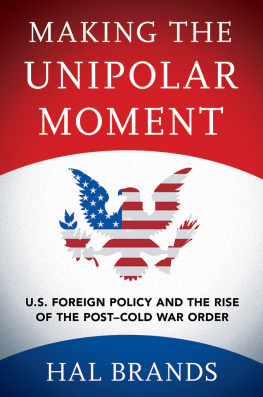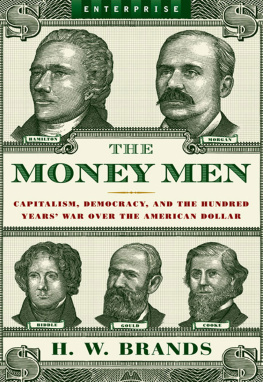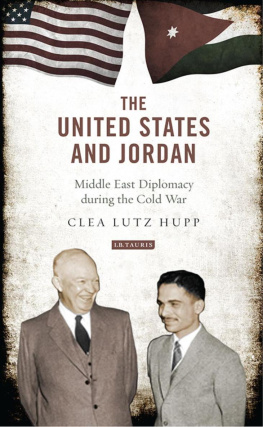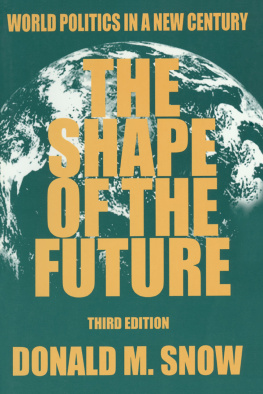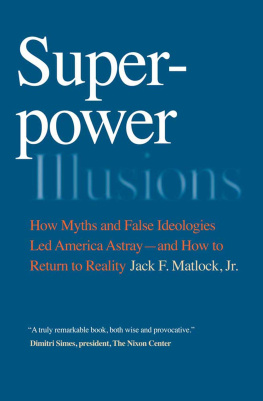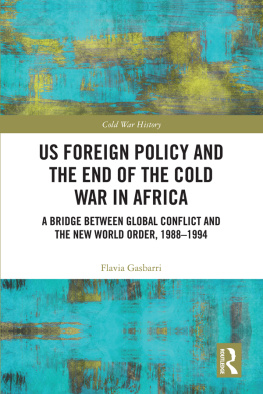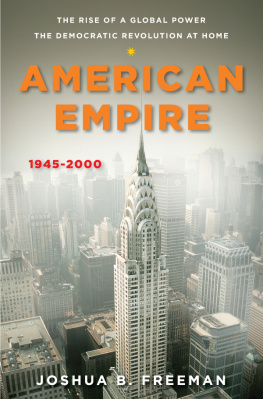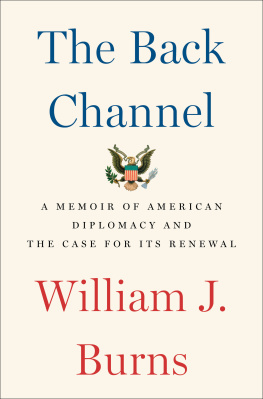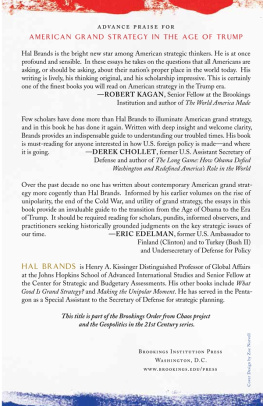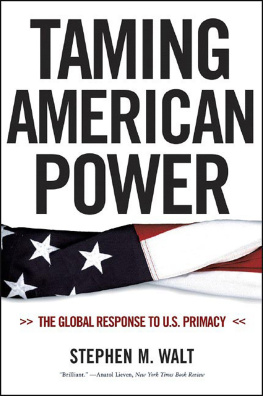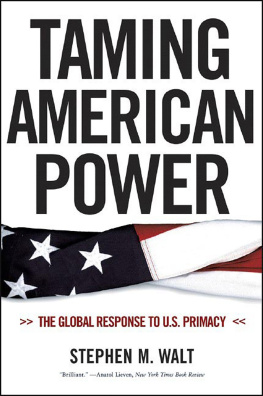ACKNOWLEDGMENTS
A books acknowledgments are rarely sufficient to convey the extent of an authors debts. I have become ever more conscious of that fact in writing this book. This book draws on research done as far back as 20042005, and on ideas that I have been mulling over for several years. It follows that I have racked up a daunting list of intellectual, professional, and personal debts along the way.
I have benefited from the assistance and guidance of archivists far too many to mention, and from the support and wonderful intellectual climate provided by my home institution, the Duke Sanford School of Public Policy. I have equally benefitted from my interaction with individuals who helped me formulate, reconsider, and refine some of the key ideas in this book. An undoubtedly incomplete list includes Colin Dueck, Charles Edel, Eric Edelman, Jeffrey Engel, John Gaddis, Peter Feaver, Bruce Jentleson, Judith Kelley, Bruce Kuniholm, Melvyn Leffler, Peter Mansoor, John Maurer, Williamson Murray, Joshua Rovner, Daniel Sargent, Josh Shifrinson, and James Wilson. I am particularly grateful to Frank Gavin, James Goldgeier, Robert McMahon, and Jeremi Suri, all of whom read the complete manuscript and offered invaluable comments. At Cornell University Press, Michael McGandy offered support along with insightful advice and was, as always, a pleasure to work with.
My greatest debts by far, of course, are owed to my family. Emily, Henry, Annabelle, and Dolly put up with a lot of long hours and authorial absentmindedness as I was researching and composing the book. But they were always unfailingly loving and supportive, and having them in my life has been the greatest inspiration I can imagine. They did more than anyone else to make this book possible. And so it is dedicated, with great love, to them.
CHAPTER 1
Roots of Resurgence
Unipolarity is a rare and valuable commodity in international affairs. It refers not simply to a situation in which a leading country has marginally more power than its competitors, but to one in which the leader has a clear and overwhelming superiority. A country that enjoys unipolarity has no near-term challengers for the status of preeminent actor in the international system; it can also do far more than any other country to shape that system to its own benefit. For a country to have unipolarity, then, is to have more than great influence over its own destiny. It is to have an unmatched say in how the broader world works.
The deepest origins of Americas postCold War unipolarity lie not in the close of the superpower conflict in 1989, or in the end of World War II a half-century earlier. They lie in the very opening of U.S. history, generations before. From its birth as a republic, the United States possessed attributes that would enable a meteoric geopolitical rise. It boasted uniquely favorable geography that offered cheap security and abundant chances for territorial enlargement, and a natural resource base that provided the foundations of awesome economic power. It was equally blessed with an energetic and fecund population, a national ideology that both impelled and rationalized American assertiveness, and a political system that generally performed well enough to let the country make the most of its other advantages. From the late 1700s to the mid-twentieth century, these characteristics permitted not just a steady accretion of U.S. power and influence; they underwrote a record of expansion and national aggrandizement that had few historical peers.
This was the long-term backdrop to what might be thought of as Americas first unipolar momentthe period after World War II. By the time the guns fell silent in 1945, the United States was preeminent in virtually all key measures of national might. In economic terms, U.S. output roughly equaled that of the rest of the world combined. In military terms, America accounted for three-quarters of great-power defense spending, and it alone possessed the atomic bomb, an air force with global striking power, and a navy that dominated the maritime commons. In diplomatic and ideological terms, no country emerged from the war with greater influence or prestige. As Melvyn Leffler has written, the United States possessed a preponderance of power.
The results of this approach were impressive by any standard, and as Daniel Sargent has written, U.S. policies erected a veritable Pax Americana.
The U.S.-led economic order was intertwined with a geopolitical and security order that was equally Washington-centric. Had the Cold War not erupted, Americas postwar geopolitical presence would not have been so extensive; the fact that the Cold War did erupt ensured that this presence soon became nearly global. The United States headed a network of military alliances that provided security and locked in American influence in key regions of the world. The country also maintained unprecedented peacetime military forces meant to provide leverage vis--vis Moscow and to substantiate these global commitments. Not least, U.S. officials used their countrys wealth and influence to affect the fate of developing nations from Latin America to Southeast Asia and beyond, in hopes of keeping them beyond the Kremlins reach and integrating them into the Western economic and political orbit. From the Marshall Plan to the Alliance for Progress, from the North Atlantic Treaty Organization (NATO) to the nuclear arms race, the outlines of the postwar world bore the imprint of American primacy.
The problem with being on top, however, is that one can only go down from there. Americas postwar dominance was based not only on its own strengths, but on the weaknesses of a world laid prone by wartime devastation. So even as Washington put its power to such productive use after World War II, that power was in relative decline. The economic recovery of U.S. allies in Europe and Asia, the gradual rise of the Kremlin as a full-fledged military and diplomatic rival, and the emergence of a growing and more assertive Third World: these trends meant that, while Americas absolute wealth and capabilities grew following the war, its comparative standing was steadily receding from the imposing heights of 1945. By the late 1960s, Richard Nixon would write that the postwar period in international relations has ended. Americas superiority had become less overwhelming; its advantages were not what they had been.
This theme of decline was particularly pervasive during the 1970sthe decade I analyze in this chapter, and one that constituted a critical inflection point in the trajectory of U.S. power. At the time, the 1970s often appeared to mark the last, dying breath of U.S. primacy. From Vietnam to Afghanistan, from the collapse of Bretton Woods to the oil shocks, American leaders confronted crises that laid bare the limits of U.S. influence and showed a superpower in retreat. More broadly, the decade produced a seeming abundance of evidence to suggest that the underlying strategic currents were unfavorable, and that Washington was inexorably losing its capacity to shape global affairs. No longer did the United States appear to be the colossus of the early postwar years; no longer did its arc seem to point upward. As one Ford-era official said, it was clear that we were in a new world in which U.S. supremacy was fading fast.
This was the impression many informed observers took away from the 1970s, and one that was often echoed in leading scholarly assessments that emerged in that decade and even after. we can now see that the history of the 1970s was neither so straightforward nor discouraging as it initially looked. To be sure, the United States was battered by crises during this period, and policymakers often seemed at a loss to deal with those challenges. But even amid such travails, the global system was undergoing profound tectonic changes that would prove immensely beneficial to the United States. The onset of the terminal decline of the Soviet empire, the emergence of a transnational human rights movement and third-wave democratization, and the rise of globalization and other economic transformationsthese trends were laying the groundwork for reinvigorated statecraft and a renewed geopolitical ascent. Appearances to the contrary, the 1970s did not represent the twilight of the American age. They were the prologue to Americas postCold War unipolar moment.

